Japanese Design Archive Survey
DESIGN ARCHIVE
Designers & Creators
Kazuo Kawasaki
Design director, Ph.D. (Medical Science)
Date: 9 July 2018, 15:00 - 17:00
Location: OUZAK Design Center
Interviewees: Kazuo Kawasaki
Interviewers: Yasuko Seki
Author: Yasuko Seki
PROFILE
Profile
Kazuo Kawasaki
Design director, Ph.D. (Medical Science)
1949 Born in Fukui Prefecture
1972 Graduated from Kanazawa College of Art, Faculty of Arts and Crafts, and joined Toshiba
1979 Established Kazuo Kawasaki Design Office
1996 Professor, Faculty of Art and Engineering, Nagoya City University
Founded OUZAK Design
1999 Ph.D. (Medical Science) from Nagoya City University
2006 Appointed professor at Graduate Schools of Osaka University (retired in 2018)
Professor emeritus, Nagoya City University
2013 Professor Emeritus, Osaka University
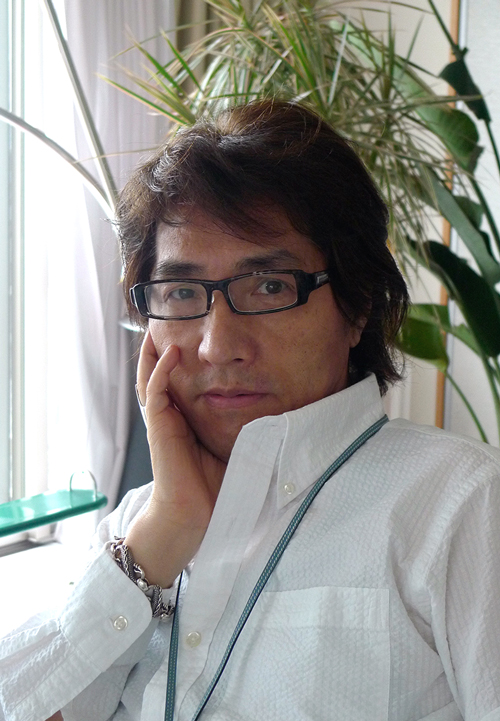
Description
Description
Kazuo Kawasaki's designs are always a step or two ahead of their time. His imagination, design theory, expressiveness and conceptual skills must have been on display from the time when he graduated from an art college and was an in-house designer at Toshiba. This is because the design development of the audio products for which he was responsible as a newcomer was carried out by Toshiba's technical development and design elite at the time (for details, see text). However, his smooth sailing life came to a major crossroads. A car accident left him in a wheelchair and he had to reconstruct his future as a designer. However, this accident became the engine for building the Kawasaki world from then on.
After leaving Toshiba, Kawasaki set up a base in his home town of Fukui and began working on a project to revive local industry through design. The company is closely connected to the local community and, like a missionary, has preached "design doctrine" to the craftspeople, rooting the mindset as design DNA in the field, rather than transient moulding design. As a result, Takefu City cutlery and Sabae City glasses have grown into global brands thanks to Kawasaki's steady efforts over more than 30 years.
Meanwhile, Kawasaki turned its attention to IT before anyone else and explored the possibilities of computers and design.
He introduced the optical moulding system, the forerunner of the now commonplace 3D printer, and challenged the application of design from ultraviolet light and semiconductors. Since then, from his position as a Ph.D. (Medical Science), he has expanded into medicine and health, disasters and radiation, and continues to suggest and pioneer new design fields. Editor Seigo Matsuoka, who is close to Kawasaki, says: "It is not the fact that he suffered a definitive physical disability that has created a new design field for Kawasaki. It was Kawasaki overcoming the obstacles that awaited him where he was going. It was because of this will to design direction that Kawasaki also product-designed a wonderful wheelchair. This is not so much a design as an "invention" or an "initiative", or rather something closer to a "determination" (Seigo Matsuoka's A Thousand Nights and a Thousand Books. Extract from 0924 Night). Kazuo Kawasaki's sharp, sharpened sense always puts himself on the edge of a cliff and says to himself, "Now what!" and take a step forward into the unexplored world, nurtured by such determination.
Masterpiece
Masterpiece
Takefu Knife series, Takefu Knife Village (1982 -); Wheelchair "CARNA" (1990), Eyeglasses "Kazuo Kawasaki" collection, MASUNAGA (1991 -); "Mind Top" and "JEEP", Apple (1991); Wall clock "HOLA", Lemnos (1989); Flex series, EIZO (1996 - ); Robots "Mai MAI" and "Odori ODORI", Osaka University (2004); LCD TV "EIZO FORIS. TV" EIZO (2004); Artificial heart Third development model "TAH" (2007); Teleglass series head-mounted display, Scalar (2007); "Peace Keeping Design" initiative (2007 - ); Keyboards "COOL LEAF Series", MinebeaMitsumi (2010); Digital blood pressure meter series, NISSEI (2010); Deep UV ray sterilizer, Osaka University (2016)
Major awards
1991 Mainichi Design Prize 1993 Kitaro Kunii Industrial Craft Award. Other awards: ICSID Special Award, BIO Award Gold Medal, German Design Award, iF Design Award Best of Group, Red Dot Design Award, French Government Design Contribution Award for Albi, SILMO 2000 Grand Prix, Design For Asia Award 2014 Bronze Award Japan Creation Grand Prize for Creativity and many more
Books
"Digital passage" ASCII (1994)ISBN 978-4756109262;
“Plato music box" ASCII (1997)ISBN 978-4756110978;
"Designers battle with yourself " ASCII (1999)ISBN 978-4756130891;
"NHK "Welcome to our extracurricular lesson" Production Group Edition "Kawasaki Kazuo Dream Designer " KTC Chuo Publishing (2002) )ISBN 978-4877582562;
“Design is beyond description ! ” ASCII (2004)ISBN 978-4756144003,
"The ultimate theory of design" ASCII (2004)ISBN-13 978-4756145307;
"The secret of the presentation" SB Creative (2005)ISBN 978-4797328202;
"Design Anthology of Kazuo Kawasaki" ASCII (2006)ISBN 978-4756147400;
"Take the initiative of design " ASCII (2006)ISBN 978-4756147981;
catalogue "Artificial heart: Kazuo Kawasaki" ASCII (2006)ISBN 978-4756148032;
Exhibition record collection "Artificial heart: Kazuo Kawasaki" 21st Century Museum of Contemporary Art, Kanazawa (2006);
“Shiro Kuramata Design - For dream memento- " MINERVA (2011)ISBN 462306011X;
“Kazuo Kawasaki Design" MINERVA (2014)ISBN 4623066630
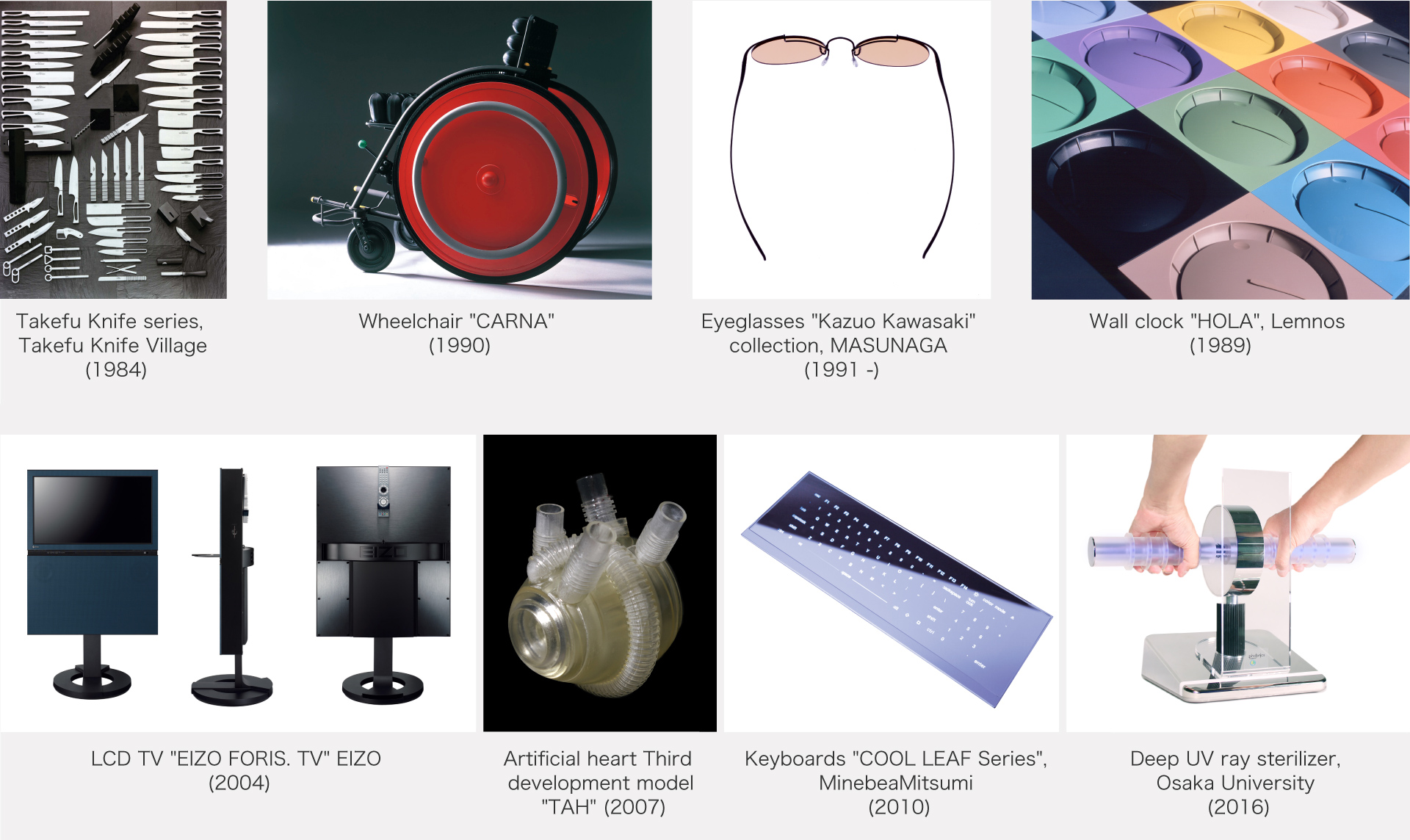
Interview
Interview
"Design language" is essential for design archives
The path to becoming a designer
― In parallel with your design activities, Dr. Kawasaki has been working on innovation in the field of medicine and health as a professor at Osaka University's Graduate School until March 2018. We would like to ask you about how you manage to do both. First of all, please tell us how you became a designer.
Kawasaki I originally wanted to go on to medical school. When I was studying for another year for the medical school entrance exam, I came across Mr. Tadanori Yokoo's work and my mind was greatly shaken. When I was wondering whether I should continue on to medical school, my mother said to me, "You are more suited to living through red paint than spending your life looking at red blood". I had always drawn imaginary drawings of rockets and robots from a young age and loved making things such as crafts, so this comment from my mother was the catalyst for me to go to art college and become a designer.
― You then went on to Kanazawa College of Art, didn't you?
Kawasaki I managed to get in, which was good, but unlike other students, I didn't have enough training in sketching and so my practical skills were terrible. During my first summer holiday, my professor told me to draw 40 pictures anyway. I remember that I was so frustrated that I drew 43 pictures and submitted them, and that I worked so hard in the sketch area that I collapsed.
― Even back then, you showed the competitive temperament that is typical of Dr. Kawasaki. How were your classes?
Kawasaki A distinctive feature of education at Kanazawa College of Art is that students make everything with their own hands. Kanazawa is a city where excellent traditional crafts have been handed down from generation to generation, and the value of making things by hand was emphasised. However, in my third year of university, I realised that I was doing something different from other students. While everyone else was making their work by hand, I was coming up with sketches and blueprints and ordering them from craftspeople. Of course, I didn't have any money, so I helped the craftsmen and cleaned their workshops, and they made the work for me. In hindsight, I liked working with my hands, but I didn't like to be assigned to anything.
― After graduation, you joined Toshiba and took your first steps as an Industrial designer.
Kawasaki In the end, I think I chose the profession of "drawing imaginary drawings", which I had liked since I was a boy. I joined Toshiba because my chief professor recommended me to do so, as I had been familiar with Moog’s synthesisers and domestic and international amplifiers since I was a student. After joining the company, I became involved with the Research and Development Center (now the Central Research Laboratory), which specialises in audio equipment, and was forced to listen to classical music all the time, so thoroughly that I was even made to study the score of Mozart's piano concerto. This was the source of my knowledge of acoustics. At the time, Toshiba's product was an electronic organ called "ORCHESTRON", but it lost out to Yamaha Corporation 's "Electone" in the market, so the company changed direction to a product for enthusiasts. So a designer I brought in from the outside became my boss, and he even taught me the circuit diagrams. The logotype was my design. Meanwhile, at Toshiba EMI he learned everything from recording to record production. The 45rpm LP number was my idea, but I have fond memories of being scolded by the artists of the time for sounding too good.
― You can't miss the computer when it comes to Dr. Kawasaki, did you first meet him when you were at Toshiba?
Kawasaki I was interested in the relationship between computers and design after I learned about the TOSBAC computer shortly after joining the company, and wondered what it would look like if a sound system was equipped with a 4-bit CPU microprocessor. Personal Computers exploded in the 1980s, but I was already working as a freelancer, so I taught myself cutting-edge 3D graphics and CAD/CAM software from the UK-based Sinclair, Alias and Silicon Graphics in the US and got more and more involved in the computer world. In 1988, I attended a computer conference in New York and there were only three Japanese participants. I felt that Japan would lose out in the future, so after returning from the US I founded the "Computer Research Association".
― Your design proposal to Apple also attracted a lot of attention.
Kawasaki Was this the concept model of the "Mind Top" notebook computer? That was designed and presented in 1991 as the next generation of the Mac. At the time, Apple's founder Mr. Steve Jobs had been fired and Mr. John Sculley was CEO. I was his first consultant, but the proposal never made it to market due to internal wrangling. Mr. Jobs later returned to the company and some people said, "Why don't you meet him", but I think we might have ended up in a falling out because of our two personalities.
― You have also designed many other projects for local industries, such as knife in your home town of Takefu in Fukui Prefecture, eyeglasses in Sabae, wheelchairs, clocks and video equipment, etc. You won the Mainichi Design Prize in 1990 and were President of the Jury for the GOOD DESIGN AWARD for three years from 2001. He has also served as the chairman of the board. What made you interested in the world of medicine again?
Designer and Ph.D. (Medical Science)
Kawasaki At the age of 28 I have a car accident and am forced to live in a wheelchair. Later, I also developed heart disease as an after-effect of a car accident, and I still have an ICD (implantable cardioverter defibrillator) in my body and have to change the batteries every few years. Soon I will have to embed it in the third generation. I became interested in medicine again because of my own body and my interest in artificial organs. The president of Nagoya City University, to whom I was invited at the time, advised me to first study physiology and then get a degree, and my appointment as a professor at the school's Faculty of Arts and Engineering gave me a new environment for my activities.
At the university, I introduced state-of-the-art equipment for optical modelling systems, now known as 3D printers, and worked on the development of an artificial heart form. The equipment was extremely expensive at the time, so I was only able to realise this because I had access to the university environment. In the course of my research, I came up with the idea of applying Klein bottle and topology-related concepts to the morphological design of the artificial heart and wrote a thesis entitled " Basic model of a total artificial heart designed by optical polymerization molding system" for which I received a Ph.D. (Medical Science), expanding my network of researchers in the medical community in Japan.
― In 2006, you left Nagoya City University to become a professor at Osaka University, and what kind of research did you do?
Kawasaki Osaka University has a wealth of unique talent, such as Professor Dr. Hiroshi Ishiguro, who is known for his robotics, and I received a lot of good inspiration from him. Therefore, in addition to the artificial heart, the research and development of the "MAI" and "ODORI" models, which embody basic robotics, the "Smart Atomic Engine", which aims to make nuclear power generation ultra-compact, and the development of battery-type models that utilise radioactivity, as well as a wide range of other research, were carried out, including the production of specific models. My interest in nuclear power and radioactivity was triggered by experiments with the University of Tokyo on a total replacement artificial heart. I also became involved in other areas such as "regenerative medicine", which is attracting a lot of attention today.
― You went to Osaka University, and your theme expanded dramatically.
Kawasaki That's right. At Osaka University, I conducted design research on artificial organs, robotics, energy, photonics, disaster, safety, security and preventive medicine. These may seem like unconnected themes at first glance, but to me they are connected by the denominator of "design for life".
― Your theory is difficult to understand, but the fact that you have produced a concrete model and not just a thesis shows your mettle as a designer who does not stop at theory on the desk, but draws an "imaginary picture" and then brings it to fruition.
Kawasaki I believe that design is about solving problems, creating value and creating the future.
― In 2015, you were appointed as a specially-appointed professor in the "Consilience Design Interdisciplinary Studio" at the Graduate School of Medicine of the same university. What is "consilience design"?
Kawasaki The consilience was coined in the context of “ Silience (wisdom
From 2015, I established and led several projects as endowed chairs in the Graduate School and Graduate School of Medicine at Osaka University. As a member, both from inside and outside the university, I invited teachers from different disciplines. The project is bearing fruit, with Mr. Hideo Hasegawa, an aerospace engineer who is a leading expert in crisis resolution, supporting my cousin in building safety and reliability.
― What specific activities are you involved in?
Kawasaki There are several. In wheelchairs, which we have been working on for many years, we have developed an "ultralight electric wheelchair" that folds down to the size of a small suitcase, thanks to innovations such as body-holding functions, lithium lightweight batteries and seating engineering. The aim is to commercialise the product by 2020. In addition, inspired by the 2014 landslide in Hiroshima, we developed a paper powder made from cellulose material, which is expected to coagulate soil, as part of our "Proposal for new decontaminatable materials". The soil in Hiroshima Prefecture is a fragile mound of granite exposed to wind and rain, which makes it prone to landslides. This is why we realised the need for a new material that could remove soil contamination in the event of a disaster and also have the potential to coagulate soil. We actually went to Asamiinami-ku in Hiroshima City and Iitate Village in Fukushima Prefecture (Photo 1) and confirmed that the material was effective not only in removing soil contamination, but also in removing radioactive substances such as caesium. Other projects included the development of a "deep ultraviolet disinfection device" based on a new concept.
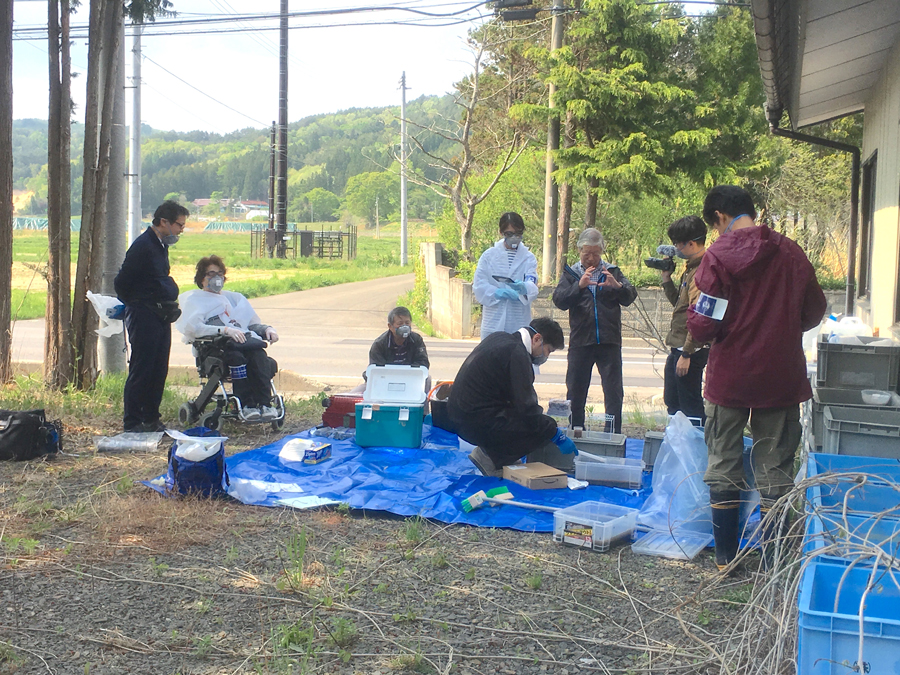
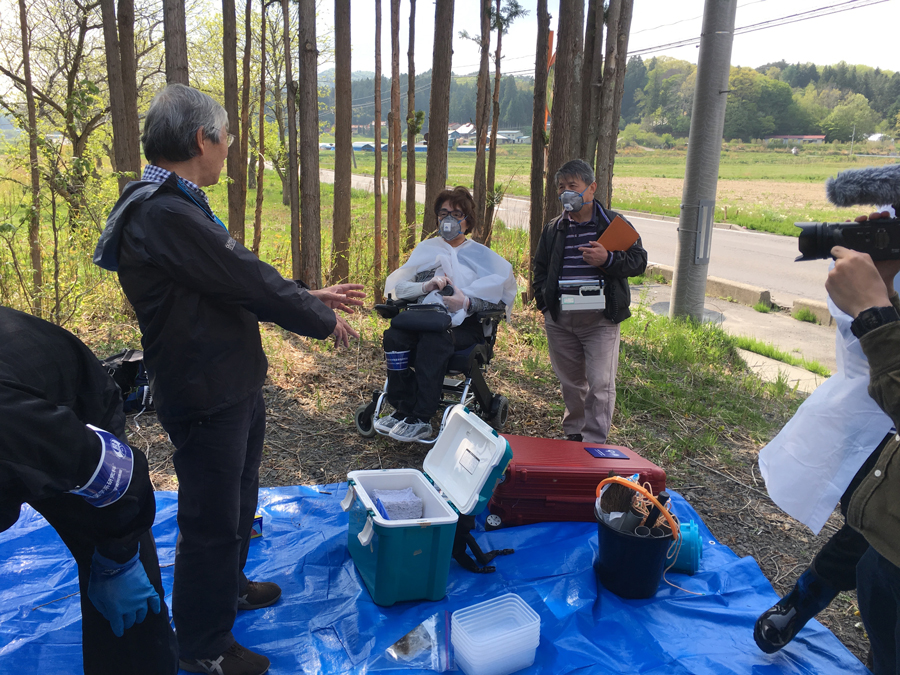
Photo 1: Experiments in Iitate village
― Are you also active in fields other than research?
Kawasaki With the aim of exploring the further possibilities of Consilience Design, I started the "KK School" in 2014, which is an acronym for my name.
― What kind of school is it?
Kawasaki Japan is a resource-poor trading nation and is prone to earthquakes, typhoons and other disasters. Against this backdrop, the Japanese have managed to get as far as we have by realising excellent “monozukuri (manufacturing) ". However, in recent years, we have been unable to see the future in cutting-edge areas such as IoT, big data and AI. The "KK School" wanted to propose the shape of Japan's future key industries and policies by inviting the participation of talented people not only from the design world and Osaka University, but also from the humanities + science and academia + arts fields. Lectures were given by robotics researcher Mr. Hiroshi Ishiguro, innovator Mr. Hideshi Hamaguchi, originator of USB flash drive, and author and professor at Osaka University's Faculty of Medicine, Mr. Yo Kusakabe.
― Since 2015, the name has changed to "KK Tekijuku", why?
Kawasaki “Tekijuku" was the name of a school founded by Ogata Koan at the end of the Edo period, which produced many talents, including Fukui-born Hashimoto Sanai and Fukuzawa Yukichi, and also led to the foundation of Osaka University. Hashimoto was beheaded at the age of 26, but excelled in learning even as a child and his ideas have many policy hints for the present day. So he dedicated his life to the "Ansei Purge" and the "Ansei great earthquakes" in the modern era. In other words, "The spirit of the Tekijuku !" I made the change in the hope that.
Design at the crossroads
― From here, we would like to ask you about design. What does design mean to you, Dr. Kawasaki?
Kawasaki To begin with, design is inseparable from beauty. However, "beauty" is subjective and "design" is objective. From another perspective, it is problem solving, value creation and future creation. However, the basis is problem solving.
― What are the specifics?
Kawasaki There are three types of answers to a problem: topic + reply, question + answer and problem + solution. What is important for a designer is not only to solve the problem at hand, but also to set something in motion within the answer. However, I am concerned that design these days seems to have become mere "decoration" rather than problem-solving and planning.
― What are some examples?
Kawasaki I was hospitalised for three months this spring. I broke a bone during a routine check-up at a hospital and had to stay there for a long time for rehabilitation. The rehabilitation hospital was creatively directed by a famous art director and was a hotel-like facility that claimed to be a "rehabilitation resort". The interior and space were very elaborate, like a resort hotel, but it left behind the spirit of what a resort should aim for, which is to make people want to come back again and again. Moreover, the main staircase, which patients also use for rehabilitation, has almost no landing from the first to the third floor and is designed to be dangerous, so that if a patient should fall, they could fall to the bottom. I was surprised, is this kind of design possible in a hospital? I believe that we should first be attentive to patient safety and security and whether the design is optimal for preventive medicine rehabilitation treatment. If it only looks good, it is just a decoration and not a real design. The design of these facilities cannot be done without the perspective of a person with a "disability". I felt that the creative directors, designers and interior designers were misdirected.
― In an interview with a magazine, Dr. Kawasaki says: "Design is about deeply pursuing the meaning of "form" and marking the heart of human "life" and "feelings'".
Kawasaki I have been in a wheelchair for 41 years and live my life not knowing when I will have a heart attack. So my design inevitably starts with "life".
― You feel a sense of crisis when it comes to design...
Kawasaki I have high hopes for digital technology, but I also feel there is a problem. One is that the very idea of design itself is inspired by digital technology. As a result, I think that design is becoming further and further removed from human feelings and the human body. Another is the spread of social media such as Instagram and Twitter. While this is certainly convenient in many ways, on the other hand, people are no longer fighting face to face with each other, and accidents and disasters are now only perceived as virtual. These trends are causing us to lose sight of the essence of design. I am concerned that there are fewer designers who can think about the world as their own, who think a lot, write a lot and make a lot of sketches, and who can think things through with their hands.
About the design archive
― I would like to move on to talk about Dr. Kawasaki's design archive. First, what is the current status of your university research results and the models you have produced?
Kawasaki Academic research is still ongoing, but these are archived by compiling them into papers and presenting them. Models created for research are stored at my home in Kyoto and in a boot room in Osaka. The same applies to models produced in the process of design development.
― What about the collections of public museums and other institutions?
Kawasaki Public institutions also have collections in foreign museums, for example, the Museum of Modern Art in New York, the Cooper-Hewitt, National Design Museum, the Smithsonian Museum, the Montreal Museum of Fine Arts, the Montreal Science Centre, the Design Center Stuttgart, the Ljubljana Museum of Architecture, the Design Centre Seoul, the Philadelphia Museum of Art and the Children's Museum of San Diego. In Japan, the 21st Century Museum of Contemporary Art, Kanazawa, where the exhibition was held, and the Fukui Children's Museum have donated some of their works.
― The exhibition "Artificial Heart: Kazuo Kawasaki Exhibition - life, feeling, form" (Photo 2) was held in 2006. That was an exhibition that summarised 35 years of Dr. Kawasaki's work. Does this mean that all of its exhibits are in the collection?
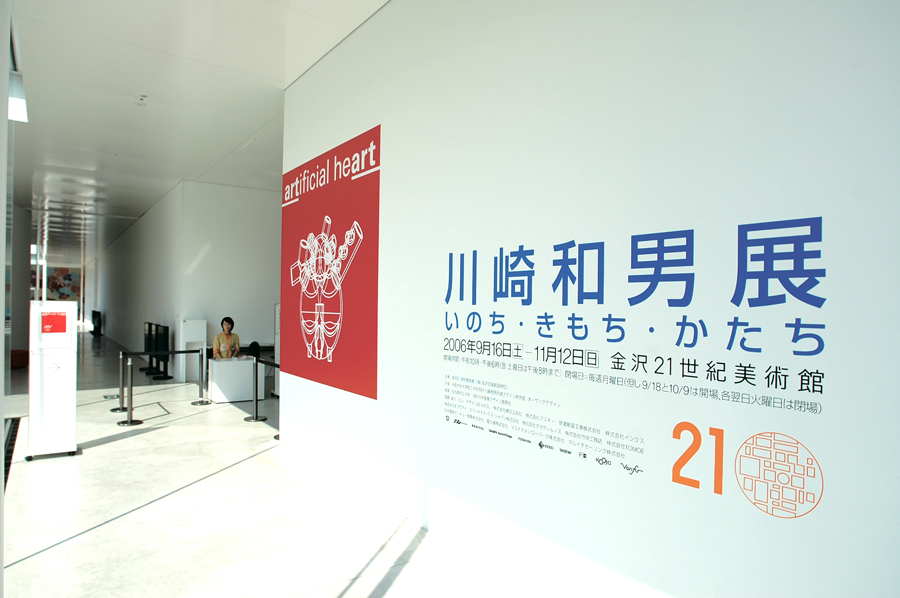
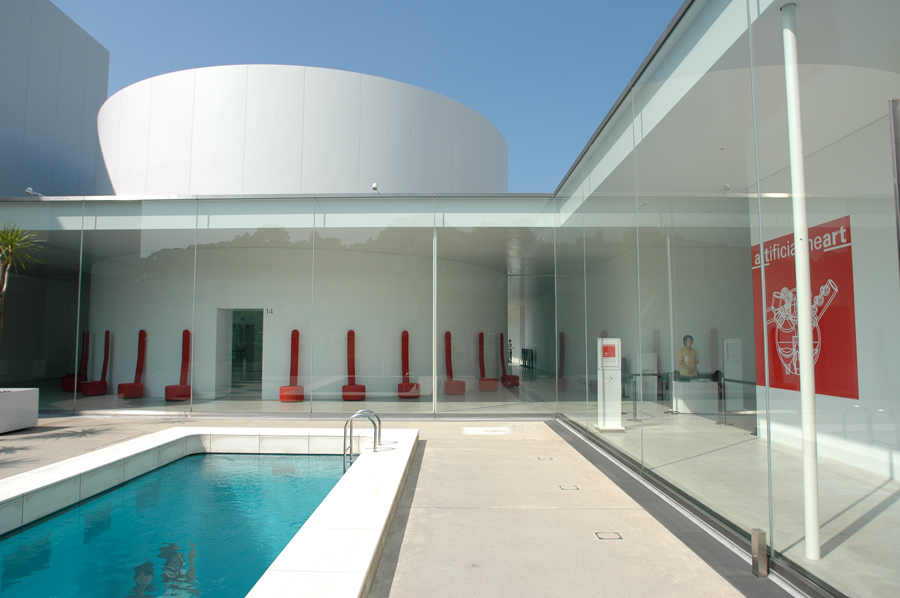
Photo 2: Exhibition at the 21st Century Museum of Contemporary Art, Kanazawa
Kawasaki Not all of them, but part of an exhibition called “Plato Music Box". This was created for my solo exhibition at the TOTO GALLERY·MA in Tokyo in 1994, and is an installation of three-dimensional music boxes designed as a tribute to 12 philosophers and artists of my choice. As well as the exhibits, I had preserved paper models and sketches, which I arranged and exhibited at the 21st Century Museum of Contemporary Art, Kanazawa, and then stored in the museum as they were.
― What about materials such as sketches and photographs?
Kawasaki I would draw a lot of sketches to deepen my thinking, but when they were commercialised I would throw them away. I didn't think it was necessary to keep the trial-and-error process of ideas. However, when I became a university student, I realised that this was not the idea of the "academic world", where everything is recorded and archived in detail. In fact, the 21st Century Museum of Contemporary Art, Kanazawa asked for hand-drawn sketches as exhibits, but there were almost none left, and the curators scolded me.
― I remember that when I interviewed Mr. Kisho Kurokawa once, he said that ideas are more important than architectural works, because Greek architecture is no longer in ruins, but Greek philosophy is still alive today. Dr. Kawasaki has published many works as well as articles. When we talk about design archives, we tend to focus on "objects" such as works and sketches, but what is your view?
Kawasaki I think designers neglect the task of verbalising their work, their creations, and preserving them as ideas. Architects, on the other hand, have a considerable amount of verbal explanation and expression. I once wrote this in “Shiro Kuramata Design - For Dream memento- "(Minerva). "As a designer, I still feel a sense of lack and dissatisfaction with design because there is so little work to 'relativise' in form and language. (omitted) Design has become fed up with the ignorant excuse that words are useless if you see, touch and use the form". I believe that designers' lack of ability to relativise form and words is one of the reasons why design journalism has not developed and why design and designers are seen as shallow. I myself am already a published author, but I am working on more archives with more "words" and "sketches".
― It is indeed difficult to translate design into language.
Kawasaki It is a pity that you cannot write a paper on design. There is a style of writing in a thesis - introduction, method, results, discussion, conclusion and development - which I think is worth incorporating in design. It is undeniable that there is a lack of verbal explanation, especially in design, as "words" were rather taken as an excuse if there is a final form. This has made it impossible to establish logic as an academic discipline and has been a factor in not being recognised by the Society for the Promotion of Science. The artificial heart project was also able to receive support (grants) from academic societies for its thesis. I have believed since my university days that "words + form" are absolutely necessary for design.
― You have a close relationship with local industries in your home prefecture of Fukui, such as cutlery in Takefu City and glasses in Sabae City. What are your views on local or public museums and archives?
Kawasaki Takefu Knife Village was started by myself and 10 other craftsmen, and although unfortunately one of us has passed away, the tradition and innovation continues today with more than 20 successors. The facility will be expanded this autumn, and in addition to exhibiting knives and giving factory tours, the aim is to hold workshops for children and the general public, and to establish a knife school for professionals. Recently, people have been talking about regional development, so Fukui Prefecture and the city of Fukui have been consulted on the idea of a museum for local industry and traditional crafts, but I think it will be difficult to make it happen. In industrial design, the Japan Industrial Design Association is doing its best by creating the "JIDA Design Museum", but I still think that this is an issue that needs to be tackled properly by a public institution.
― This time, we received the perspective of language and design archiving. Thank you very much for your time.
Enquiry:
Kazuo Kawasaki
http://www.kazuokawasaki.jp/
OUZAK Design Center
http://www.ouzak.co.jp/

